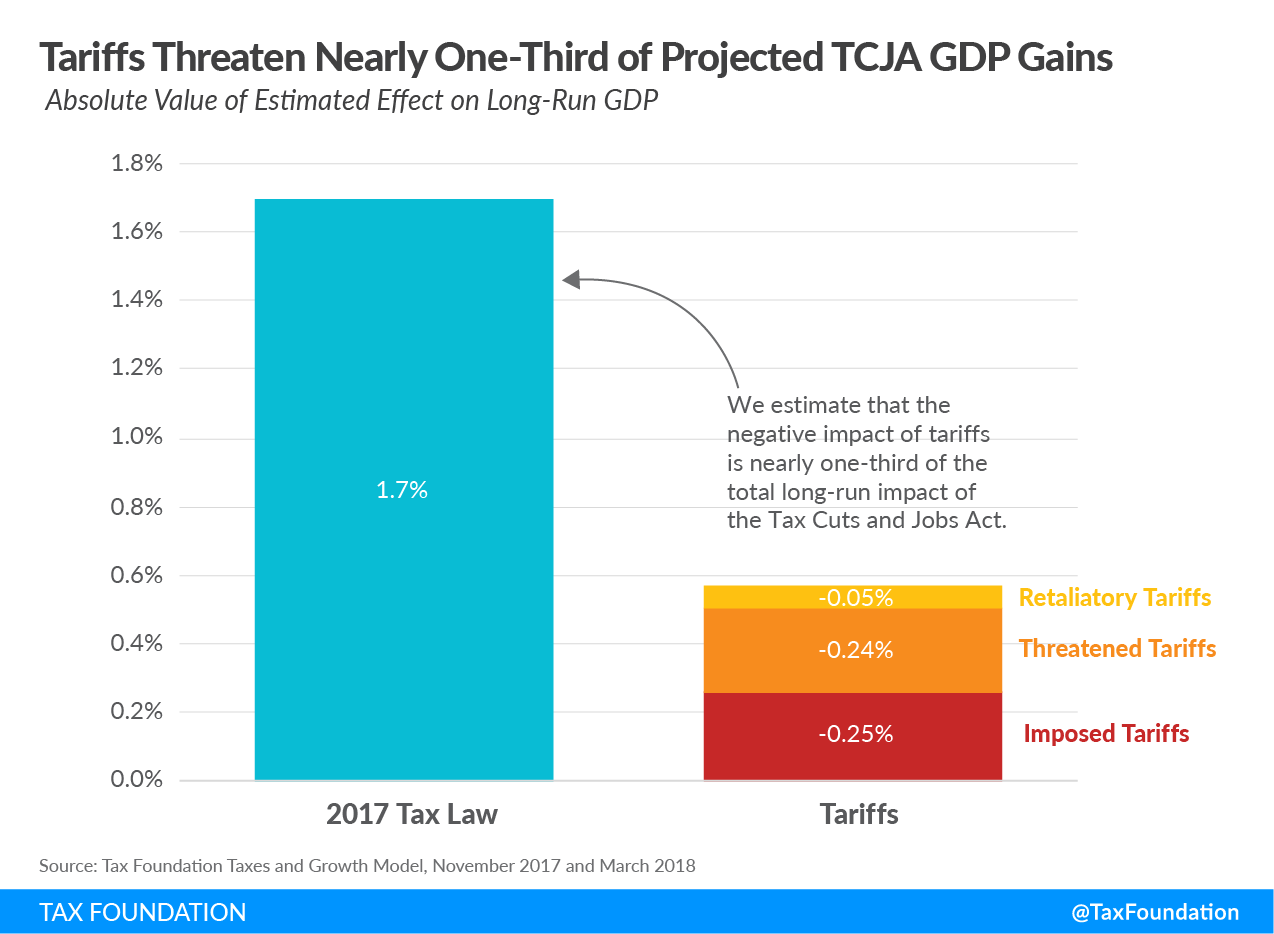Trump's Trade War: 8 Key Impacts On The Canadian Economy

Table of Contents
Increased Costs for Canadian Businesses and Consumers
Trump's trade war directly increased costs for Canadian businesses and consumers through various mechanisms. The imposition of tariffs created ripple effects throughout the economy.
Tariffs on Steel and Aluminum
The tariffs imposed on Canadian steel and aluminum exports led to higher production costs across numerous sectors. This had a cascading effect:
- Increased prices for finished goods: Manufacturers passed increased input costs onto consumers, leading to higher prices for everything from cars to construction materials.
- Reduced competitiveness in global markets: Canadian businesses faced higher production costs, making them less competitive against international rivals who did not face similar tariffs.
- Potential job losses in affected industries: Some businesses struggled to remain profitable, leading to potential job losses and factory closures in sectors reliant on steel and aluminum. The impact was particularly felt in Ontario and Quebec.
Retaliatory Tariffs
Canada responded to the US tariffs with retaliatory tariffs on various US goods. This created a cycle of escalating costs:
- Increased prices for imported US goods: Consumers faced higher prices for a range of imported goods from the US, impacting household budgets.
- Reduced consumer spending power: Higher prices led to reduced consumer spending power, negatively impacting overall economic growth.
- Negative impact on businesses reliant on US imports: Businesses dependent on US imports saw their input costs rise, potentially affecting their profitability and competitiveness.
Disruption to Supply Chains
The uncertainty generated by Trump's trade war significantly disrupted established supply chains between Canada and the US.
Uncertainty and Delays
The unpredictable nature of the trade war created considerable uncertainty and delays in cross-border trade:
- Increased logistical costs: Businesses faced higher costs associated with navigating complex trade regulations and dealing with delays.
- Production delays and shortages: Disruptions to the flow of goods led to production delays and shortages of essential materials.
- Damage to long-term business relationships: The uncertainty eroded trust and damaged long-term relationships between Canadian and US businesses.
Diversification Efforts
In response to the instability, Canadian businesses actively sought to diversify their supply chains:
- Increased investment in relationships with other trading partners: Companies looked to establish alternative sources of supply in countries like Mexico, the EU, and Asia.
- Potential for long-term economic benefits through diversification: While initially costly, diversification ultimately reduced reliance on a single trading partner, leading to greater economic resilience.
Impact on Specific Canadian Industries
Several Canadian industries felt the brunt of Trump's trade war more acutely than others.
Agriculture
The Canadian agricultural sector suffered significantly:
- Reduced exports to the US market: Tariffs on dairy, pork, and other agricultural products hampered Canadian exports to the US, a major market.
- Increased competition from other global producers: Canadian farmers faced increased competition from other countries less affected by the trade war.
- Government support programs to mitigate losses: The Canadian government implemented support programs to help farmers cope with the economic fallout.
Automotive
The deeply integrated automotive industry faced considerable challenges:
- Production slowdowns and workforce adjustments: Disruptions to the supply chain caused production slowdowns and workforce adjustments in Canadian auto plants.
- Increased costs for auto parts and vehicles: Higher costs for imported auto parts led to increased prices for vehicles.
- Negotiations for new trade agreements to secure supply chains: The trade war intensified efforts to renegotiate trade agreements to secure reliable supply chains.
Changes in Trade Relationships
Trump's trade war acted as a catalyst for significant changes in Canada's trade relationships.
Strengthening of USMCA
The trade war highlighted the need for a stable North American trade agreement:
- Increased certainty for Canadian businesses trading with the US and Mexico: The renegotiated USMCA provided greater certainty and predictability for Canadian businesses.
- Potential for increased trade and economic growth under the new agreement: The USMCA aimed to facilitate increased trade and economic growth within North America.
Diversification of Trade Partners
Canada actively pursued trade diversification beyond the US:
- Increased trade with Asia, Europe, and other regions: Canada strengthened trade ties with various countries to reduce reliance on the US market.
- Long-term benefits of a more diversified trade portfolio: A diversified trade portfolio enhances economic resilience and reduces vulnerability to shocks from a single market.
Economic Slowdown and Job Market Impacts
Trump's trade war contributed to a slowdown in Canadian economic growth and impacted the job market.
Reduced Economic Growth
The trade war negatively affected the Canadian economy:
- Decreased investment and business confidence: Uncertainty surrounding the trade war reduced investment and business confidence.
- Impact on overall GDP: The trade war contributed to a slowdown in overall GDP growth.
- Government interventions to stimulate economic activity: The government implemented various measures to stimulate economic activity and mitigate the negative impacts.
Job Losses and Uncertainty
Sectors directly exposed to US tariffs faced job losses and uncertainty:
- Increased unemployment in specific industries: Job losses were particularly pronounced in industries heavily reliant on US exports.
- Government retraining programs to support affected workers: The government provided retraining programs to help displaced workers transition to new jobs.
Impact on the Canadian Dollar
The trade war led to fluctuations in the value of the Canadian dollar.
Currency Fluctuations
The uncertainty surrounding the trade war affected the Canadian dollar:
- Impact on exports and imports: Fluctuations in the Canadian dollar impacted the price competitiveness of Canadian exports and imports.
- Uncertainty for businesses involved in international trade: Currency volatility added another layer of uncertainty for businesses engaged in international trade.
Increased Government Spending and Debt
The Canadian government incurred increased spending and debt in responding to the trade war.
Support Programs
The government implemented support programs for affected businesses and workers:
- Increased government debt: The cost of these programs added to the government's overall debt.
- Long-term fiscal implications: The increased debt had long-term fiscal implications for the Canadian government.
Long-Term Effects and Lessons Learned
Trump's trade war, while disruptive, provided valuable lessons for Canada.
Resilience and Adaptation
The Canadian economy demonstrated resilience and adaptability:
- Importance of diversification and strategic trade relationships: The experience highlighted the importance of diversifying trade relationships and building strong strategic alliances.
- Lessons learned for navigating future economic shocks: Canada gained valuable experience in managing economic shocks and adapting to changing global trade dynamics.
Conclusion:
Trump's trade war left a lasting mark on the Canadian economy. The increased costs, supply chain disruptions, and impacts on specific sectors underscore the interconnected nature of global trade. While the USMCA provided some stability, the experience highlighted the importance of diversifying trade relationships and building economic resilience. Understanding the lasting impacts of Trump's trade war is crucial for navigating future economic challenges and securing Canada's long-term economic prosperity. To learn more about the ongoing effects of trade policies on the Canadian economy, continue researching the impact of Trump's trade war and its implications for Canadian businesses.

Featured Posts
-
 Fridays Surprise Deutsche Banks Distressed Sales Head Moves To Morgan Stanley
May 30, 2025
Fridays Surprise Deutsche Banks Distressed Sales Head Moves To Morgan Stanley
May 30, 2025 -
 The Bruno Fernandes Transfer That Almost Was Manchester United Vs Tottenham
May 30, 2025
The Bruno Fernandes Transfer That Almost Was Manchester United Vs Tottenham
May 30, 2025 -
 Reembolsos Ticketmaster Proceso Paso A Paso Tras La Cancelacion Del Axe Ceremonia 2025
May 30, 2025
Reembolsos Ticketmaster Proceso Paso A Paso Tras La Cancelacion Del Axe Ceremonia 2025
May 30, 2025 -
 Pasxalines Tileoptikes Metadoseis E Thessalia Gr Odigos Programmatos
May 30, 2025
Pasxalines Tileoptikes Metadoseis E Thessalia Gr Odigos Programmatos
May 30, 2025 -
 French Open 2024 Swiateks Strong Showing Amidst Ruud And Tsitsipas Losses
May 30, 2025
French Open 2024 Swiateks Strong Showing Amidst Ruud And Tsitsipas Losses
May 30, 2025
Latest Posts
-
 Rising Covid 19 Cases Is A New Variant To Blame
May 31, 2025
Rising Covid 19 Cases Is A New Variant To Blame
May 31, 2025 -
 New Covid 19 Variant A Global Health Concern
May 31, 2025
New Covid 19 Variant A Global Health Concern
May 31, 2025 -
 Who Warns New Covid 19 Variant Fueling Case Surges Globally
May 31, 2025
Who Warns New Covid 19 Variant Fueling Case Surges Globally
May 31, 2025 -
 Tracking The Spread New Covid 19 Variant And Rising Case Numbers Nationally
May 31, 2025
Tracking The Spread New Covid 19 Variant And Rising Case Numbers Nationally
May 31, 2025 -
 National Increase In Covid 19 Cases A New Variant Emerges
May 31, 2025
National Increase In Covid 19 Cases A New Variant Emerges
May 31, 2025
